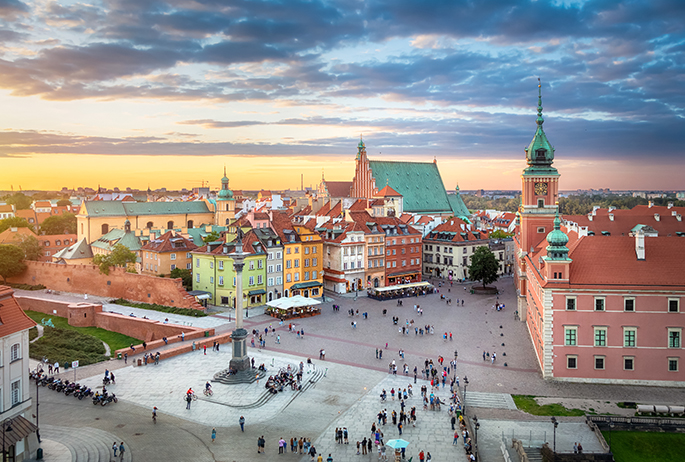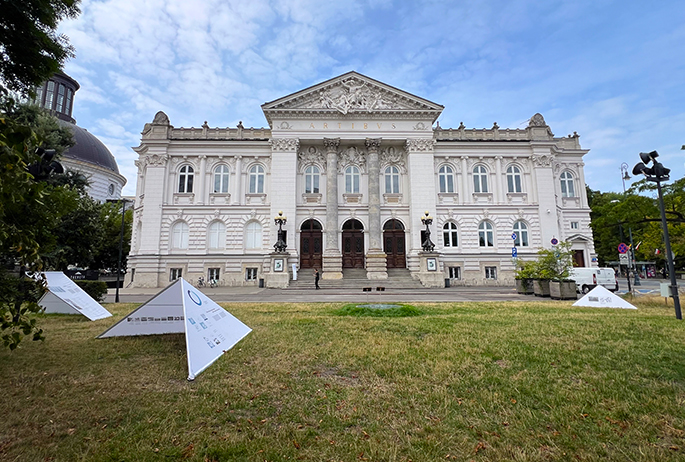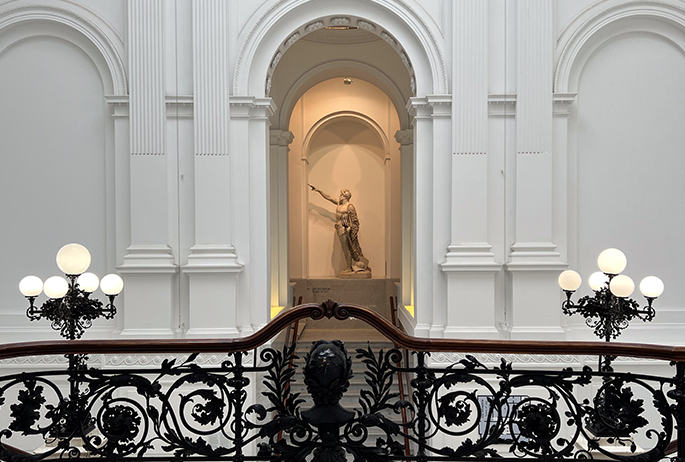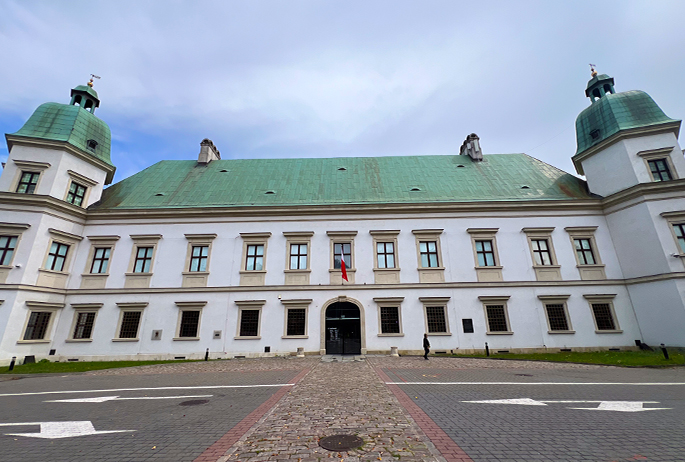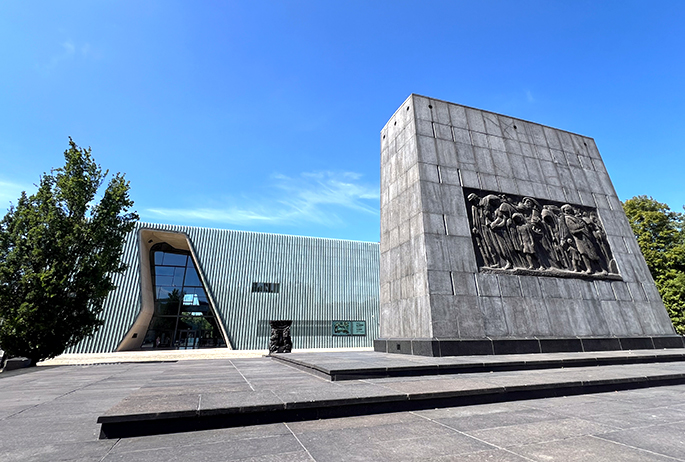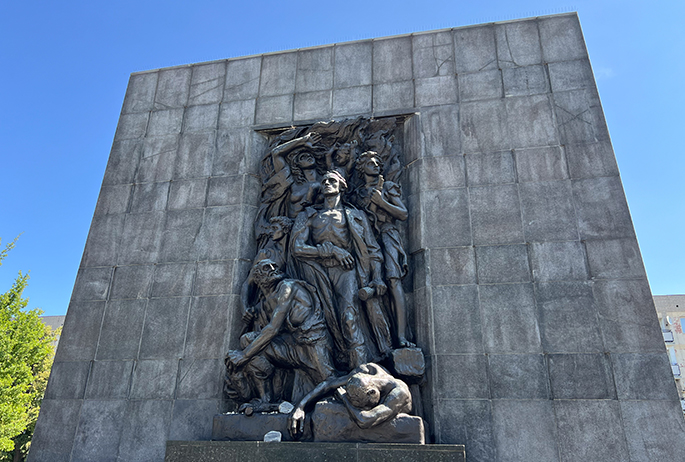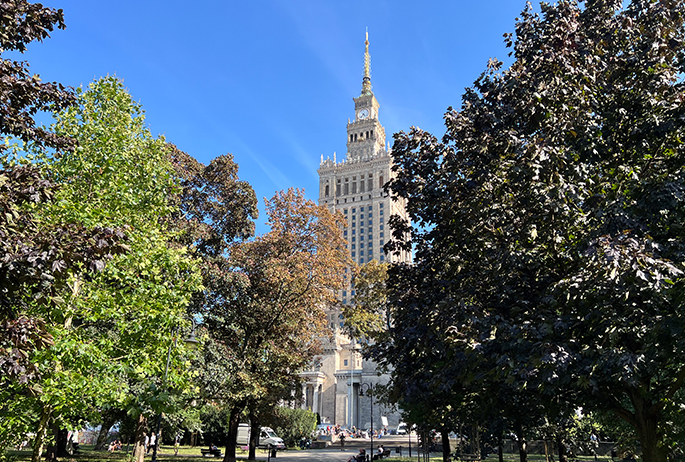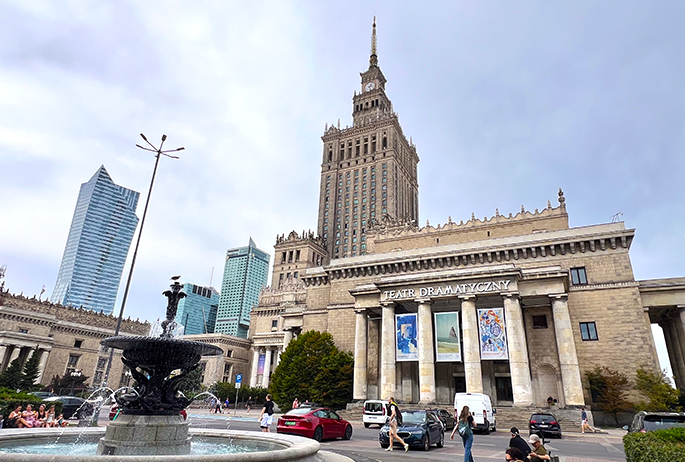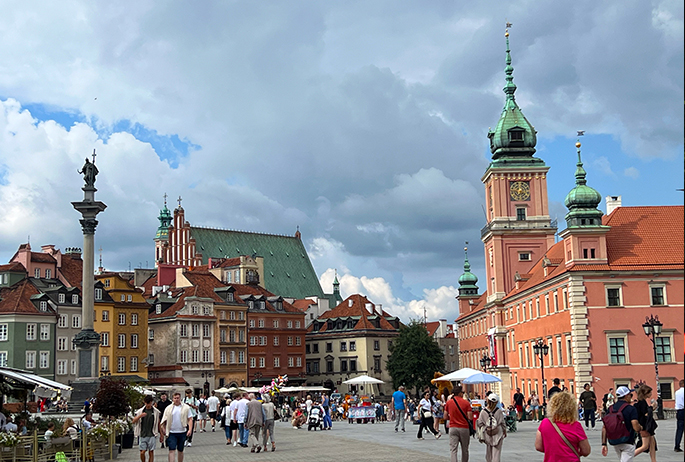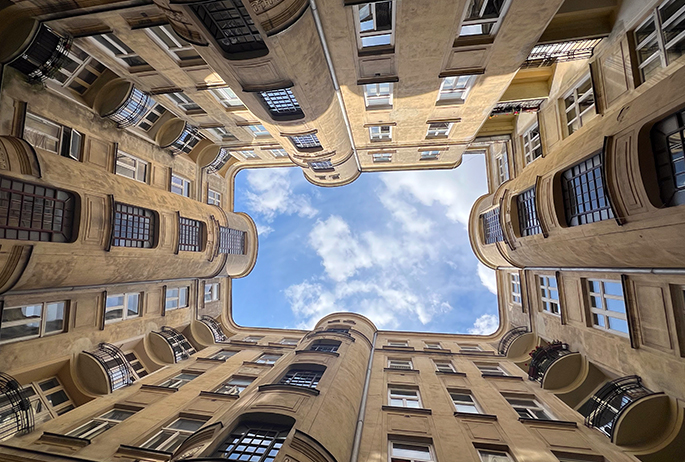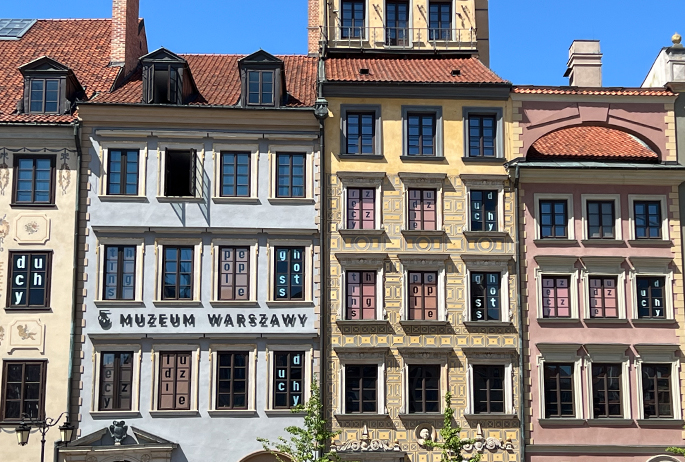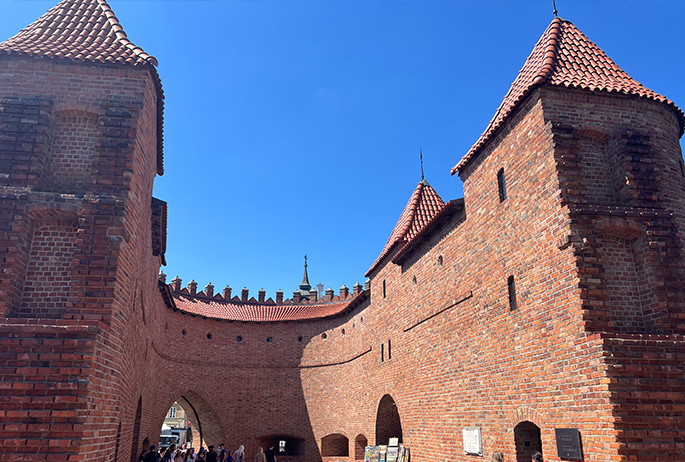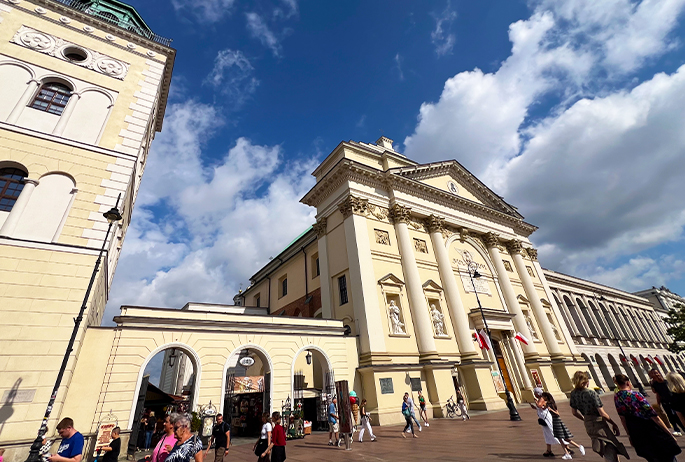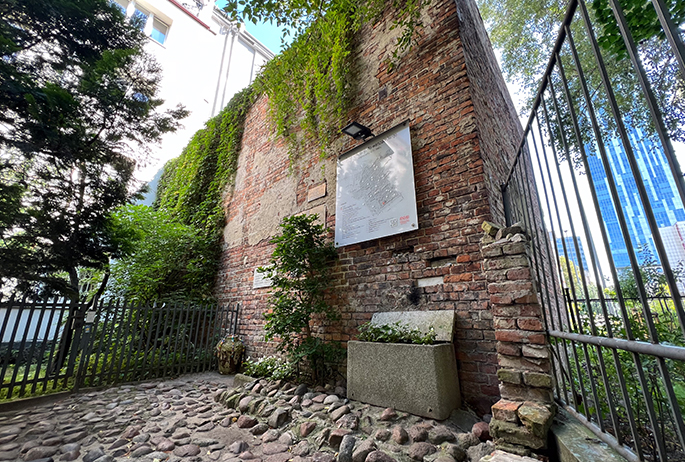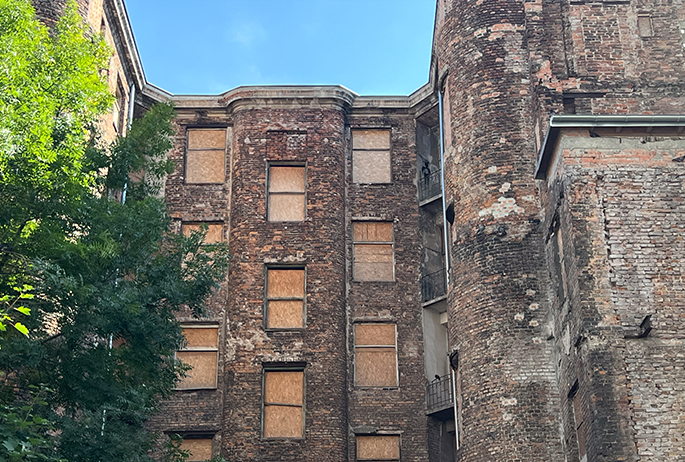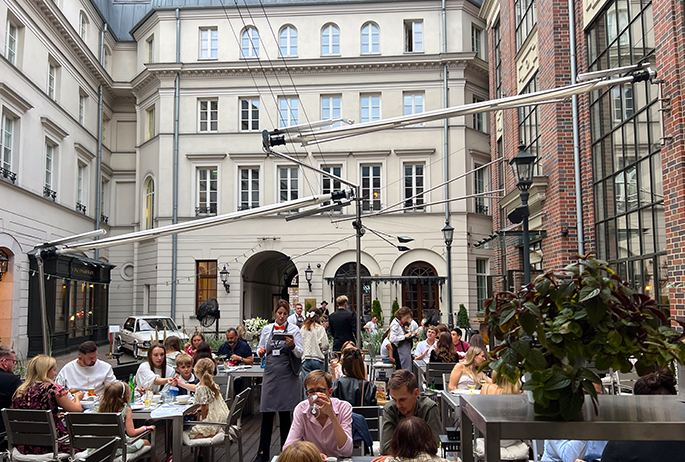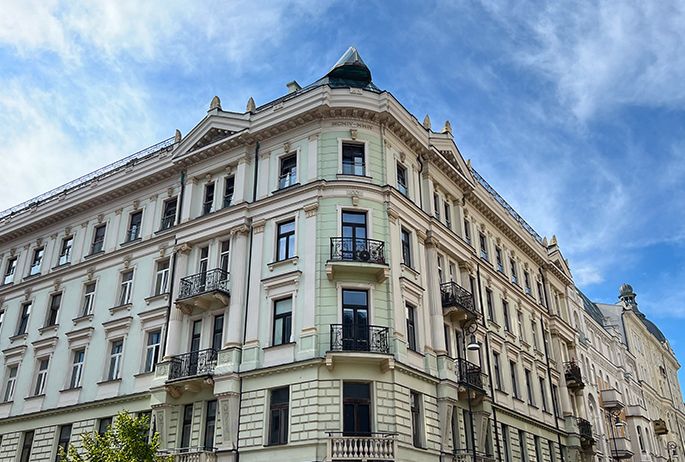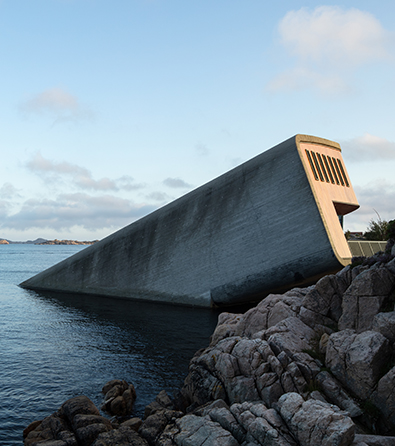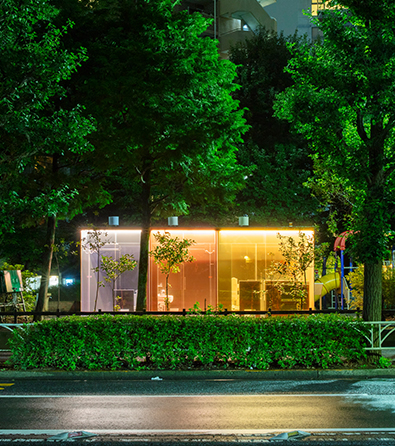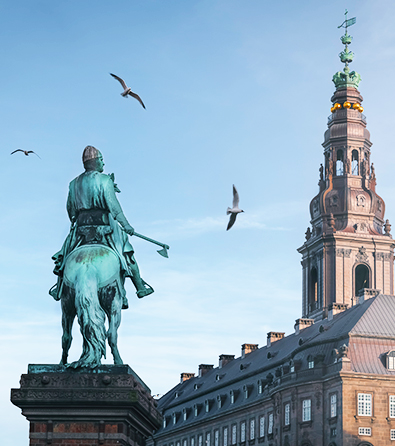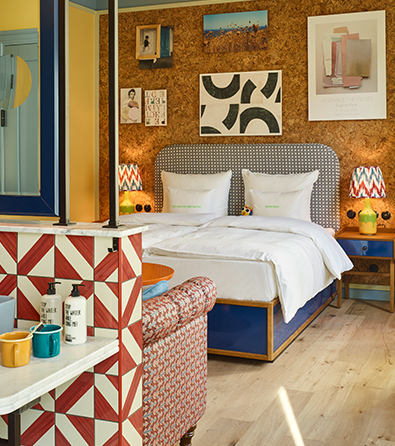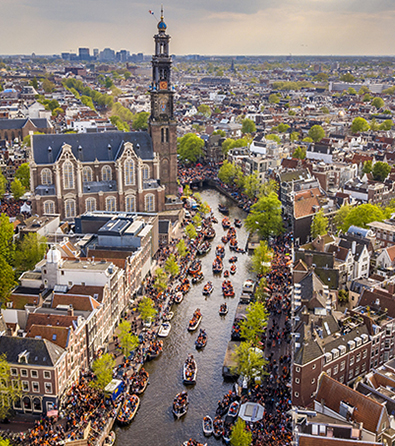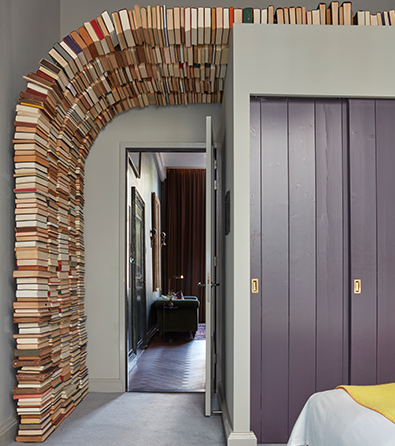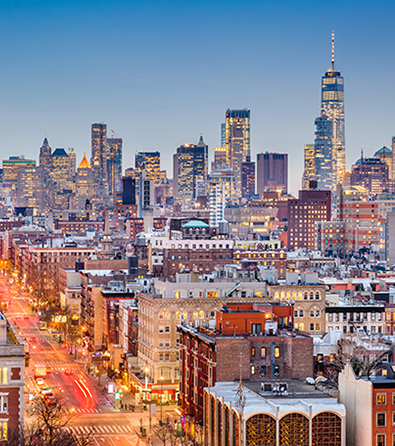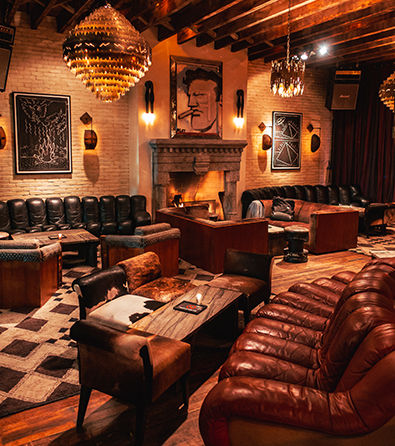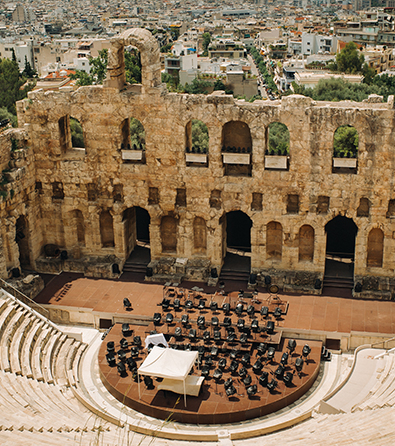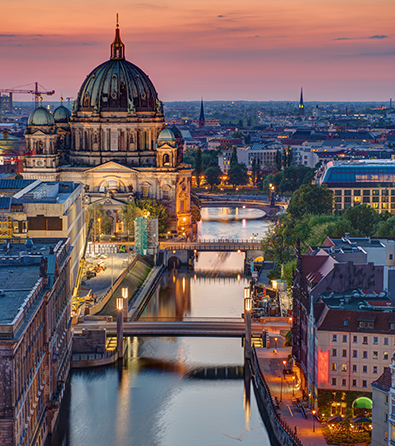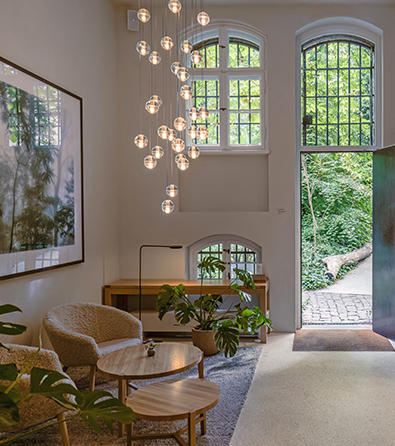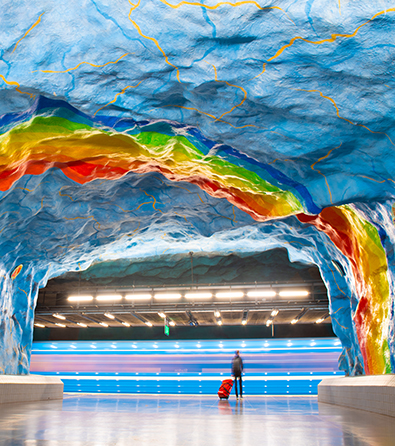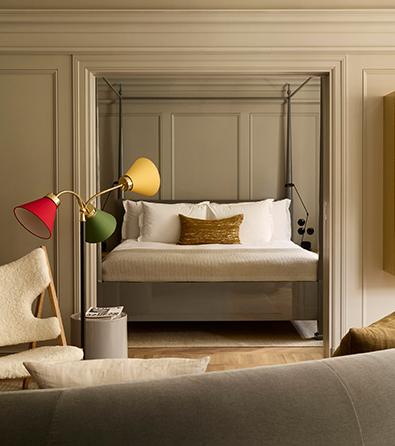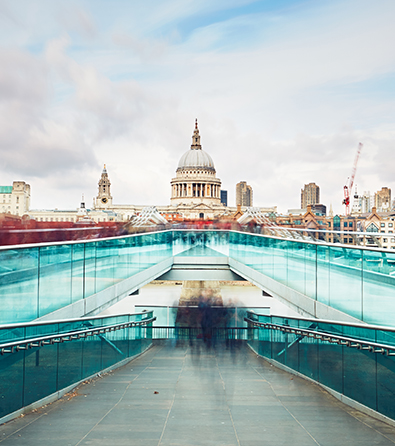Warsaw, Poland’s capital, is a city shaped by resilience, creativity, and transformation. Nearly destroyed during World War II, it was thoroughly rebuilt, most notably the historic Old Town, now a UNESCO World Heritage Site. After decades under Soviet influence, the city entered a new era in 2004 with Poland’s accession to the European Union, sparking a cultural and architectural revival. Today, Warsaw art and design flourish across museums, galleries, and public spaces, blending its rich heritage with a thriving contemporary art scene. For travelers and culture lovers, the city offers a unique cultural experience where history and innovation meet.
To access our exclusive Warsaw Treasure Map, simply click the attached link and become a Culture Treasures member. The map pins every place in this guide and adds bonus cafés, boutiques and cultural venues. Planning your stay? Our curated hotel recommendations, featured at the end of this guide, highlight the best design-forward accommodations in Warsaw., along with our curated urban travel essentials and long flight essentials for a comfortable journey.
Art:
Ujazdowski Castle Centre for Contemporary Art (Ujazdów / Central Warsaw)
Why go: A rare fusion of royal history and contemporary art, offering cutting-edge exhibitions in an 18th-century reconstructed castle.
Tip: Don’t miss the artist residency program and experimental film screenings in the on-site cinema.
Originally a royal residence, Ujazdowski Castle was reconstructed in the 1970s and has housed the Centre for Contemporary Art since 1985. This dynamic institution has presented over 600 exhibitions spanning visual arts, performance, and multimedia. In addition to its thought-provoking shows, the Centre offers a robust public program with workshops, lectures, and residencies that draw both local and international artists. Visitors can also enjoy its cinema, library, and nearby parks, including Łazienki and Ujazdowski, which provide a serene backdrop to this vibrant cultural hub.
Zachęta National Gallery of Art (Śródmieście / Central Warsaw)
Why go: Poland’s leading contemporary art institution, known for landmark exhibitions and its role in the Venice Biennale.
Tip: Check the schedule for temporary exhibitions by both emerging and established Polish and international artists.
Founded in 1860 and housed in a neoclassical building with an impressive grand entrance, Zachęta National Gallery of Art stands at the heart of Warsaw’s cultural landscape. The gallery features a wide range of contemporary works across painting, sculpture, photography, and multimedia installations. As the official organizer of Poland’s pavilion at the Venice Biennale, Zachęta plays a key role in representing Polish art on the global stage. With a commitment to critical dialogue and artistic experimentation, the gallery offers visitors an engaging and thought-provoking experience at the intersection of tradition and innovation.
Zachęta Project Room (Gałczyńskiego Street / Central Warsaw)
Why go: A cutting-edge space for emerging Polish artists and experimental contemporary art.
Tip: Entry is often free, ideal for spontaneous visits and discovering new talent.
Located at 3 Gałczyńskiego Street, the Zachęta Project Room functions as an innovative satellite of the Zachęta National Gallery of Art. Dedicated to experimentation and new voices in the art world, this flexible exhibition space serves as both a creative laboratory and a launchpad for up-and-coming artists. The Project Room hosts a rotating program of exhibitions, installations, and performances that reflect the most current trends in Polish and international contemporary art. Its intimate scale invites viewers into a direct encounter with the creative process and fosters fresh dialogue around emerging artistic practices.
Museum of Modern Art in Warsaw (Muzeum nad Wisłą / Vistula Riverbank)
Why go: A leading venue for contemporary art in Poland, spotlighting socially engaged and experimental work.
Tip: Visit on Thursday evenings for special programming, talks, or exhibition openings.
Located along the scenic banks of the Vistula River, the Museum of Modern Art in Warsaw, known locally as Muzeum nad Wisłą, occupies a sleek, minimalist space designed by Austrian architect Adolf Krischanitz. While this serves as a temporary home before the museum moves to its forthcoming permanent building, the venue plays a major role in Poland’s cultural landscape. Its exhibitions emphasize the intersection of contemporary art and pressing social issues, showcasing both emerging and established artists from Poland and around the world. Visitors can expect a vibrant mix of visual art, film, installations, and performances that challenge perceptions and stimulate critical dialogue.
Centre of Polish Sculpture in Orońsko (Orońsko / Masovian Voivodeship)
Why go: A one-of-a-kind sculpture park and cultural complex set in a 19th-century estate, dedicated to contemporary Polish and international sculpture.
Tip: Allocate at least half a day to explore the park, galleries, and studios, and check ahead for artist-in-residence open studios or workshops.
Situated about 120 kilometers south of Warsaw in the idyllic village of Orońsko, the Centre of Polish Sculpture (Centrum Rzeźby Polskiej w Orońsku) offers a profound artistic retreat in a historic setting. The estate, once home to 19th-century painter Józef Brandt, now functions as a dynamic hub for contemporary sculpture. The complex includes expansive outdoor sculpture gardens, multiple indoor galleries, and a dedicated Museum of Contemporary Sculpture. Through exhibitions, artist residencies, and international collaborations, the Centre fosters experimentation and dialogue in three-dimensional art, making it one of Poland’s most significant platforms for sculptural practice.
Raster Gallery (Warsaw / Śródmieście District)
Why go: One of Central Europe’s most influential contemporary art galleries, known for its experimental programming and international artist collaborations.
Tip: Visit during exhibition openings or events to experience the gallery’s vibrant cultural network and discover rising talents in Polish contemporary art.
Founded in 2001 by art critics Łukasz Gorczyca and Michał Kaczyński, Raster Gallery quickly established itself as a leading voice in the contemporary art scene of Warsaw and beyond. Emerging from their earlier ventures, such as the Raster art magazine and the experimental Naświetlarnia (Exposure Room) garage gallery, Raster maintains a strong commitment to artistic innovation and critical dialogue. Its curatorial program presents a dynamic mix of established and emerging artists, both Polish and international, often challenging traditional gallery formats. Notable initiatives like the “Villa” series reimagine the boundaries of art exhibition and market engagement, reinforcing Raster’s reputation as a platform for bold and unconventional creativity.
Foksal Gallery (Warsaw / Śródmieście District)
Why go: A historic avant-garde gallery that played a pivotal role in shaping contemporary Polish art through experimental and non-commercial exhibitions.
Tip: Look out for archival exhibitions and publications that highlight the gallery’s radical legacy and influential founders.
Established in 1966 by artists and critics including Tadeusz Kantor, the Foksal Gallery became a groundbreaking force in Poland’s postwar art scene. From its inception, the gallery emphasized conceptual and performance-based practices, positioning itself at the forefront of avant-garde movements in Eastern Europe. The architectural design by Oskar Hansen reflects its minimalist philosophy, prioritizing the artworks and fostering a space for intellectual exploration. Remaining steadfast in its non-commercial approach, Foksal continues to promote innovation and critical discourse in contemporary art, earning its reputation as a vital platform for artistic experimentation and historical reflection.
Design and Architecture:
Gallery of Polish Design (Warsaw / National Museum)
Why go: A comprehensive overview of Polish design history from the early 20th century to today, highlighting the country’s creativity and resilience through applied arts.
Tip: Follow the chronological layout to trace design evolution from the Bauhaus-influenced interwar years to contemporary Polish innovations.
Located within the National Museum in Warsaw, the Gallery of Polish Design offers an exceptional window into the evolution of Polish design over the past century. This permanent exhibition features furniture, ceramics, textiles, glassware, and everyday objects that reflect the aesthetic and cultural shifts experienced by Poland across key historical periods. Visitors can explore how designers adapted during the interwar avant-garde, the challenges of communist-era production, and the explosion of creative freedom in the post-1989 and contemporary eras. The gallery not only preserves iconic objects but contextualizes them within Poland’s social, political, and technological transformations, offering a unique and educational experience for design lovers.
University of Warsaw Library (Warsaw / Powiśle District)
Why go: A striking example of modern Polish architecture, featuring one of Europe’s largest rooftop gardens and a light-filled interior designed for study and reflection.
Tip: Don’t miss the panoramic views from the green roof, access is free and open to the public year-round.
Designed by architects Marek Budzyński and Zbigniew Badowski, the University of Warsaw Library (BUW) is a contemporary architectural landmark completed in 1999. Blending steel, glass, and concrete with vibrant vegetation, the building is best known for its sprawling rooftop garden, which spans over 10,000 square meters and includes thematic zones, water features, and walking paths. This green roof integrates nature with urban space and offers stunning views of the Vistula River and the Warsaw skyline. Inside, the library’s open-plan design creates a bright and welcoming environment with spacious reading rooms, modern art installations, and a variety of study and exhibition areas. Located in the lively Powiśle district, BUW is a hub for students, scholars, and visitors alike.
Keret House (Warsaw / Wola District)
Why go: An extraordinary architectural landmark and one of the narrowest houses in the world, symbolizing innovation in urban design.
Tip: Visits are limited and by appointment only, check for residency events or open days in advance.
Tucked between two buildings in Warsaw’s Wola district, Keret House was designed by architect Jakub Szczęsny and completed in 2012. Measuring just 122 cm at its widest and 72 cm at its narrowest, this ultra-slim structure stands as a provocative commentary on density, space, and creativity in contemporary architecture. Named after Israeli writer Etgar Keret, who was the first guest to stay there, the house functions as both a live-in installation and a space for artist residencies. Despite its size, the structure is fully equipped with a bedroom, bathroom, and kitchenette, showcasing how minimalist design can be both functional and imaginative. Its location on the historical intersection of Chłodna and Żelazna Streets further adds cultural significance, as the area once marked the boundary of the Warsaw Ghetto.
Shopping Delight:
Mysia 3 is a unique and stylish boutique shopping center, located in a repurposed tenement building near the city center. Spread across three floors, Mysia 3 hosts a variety of shops offering fashion, art, and home decor by both Polish and international designers. The venue is particularly popular for its curated selection of contemporary and luxury brands, making it a go-to destination for those looking for unique fashion pieces, accessories, and designer items. In addition to fashion and design, Mysia 3 also features a photography gallery and a vinyl record store, adding to its cultural appeal. The building’s history adds another layer of interest; it was once used by the communist government for censorship activities, which contrasts sharply with its current role as a beacon of creativity and freedom of expression.
TFH Koncept is a dynamic and eclectic concept store located in the city center, known for its unique blend of fashion, design, and art. The store spans three floors, each offering a curated selection of avant-garde clothing, accessories, home decor, and art pieces. It focuses on showcasing the work of designers from Poland and Eastern Europe, making it a hotspot for those interested in cutting-edge and unconventional styles.
Typogram is a prominent graphic design studio and shop known for its focus on typography and print design. Visitors to the shop can find a curated selection of items such as custom-designed posters and other print materials, all created with a strong emphasis on typography and high-quality design.
Look Inside is a charming design and vintage shop located in the Nowa Praga district. This unique store is nestled within a 19th-century tenement house, offering a carefully curated selection of both vintage and contemporary design pieces. The shop is a treasure trove for those who appreciate the aesthetics of the past, featuring a wide range of items from antique furniture and retro home decor to exquisite ceramics and Scandinavian design objects.
Take a Break:
Bułkę przez Bibułkę is a trendy café known for its delicious breakfast options, gourmet sandwiches, salads, smoothies and cozy atmosphere. Located in various spots around the city, it’s a favorite for both locals and tourists looking for a relaxed place to enjoy quality food and coffee.
Różana is a charming and elegant restaurant in Warsaw, renowned for its refined Polish cuisine and warm, inviting atmosphere. In a beautifully restored pre-war villa in the Mokotów district, Różana offers a dining experience combining traditional Polish flavors. The restaurant’s ambiance, enhanced by vintage decor and fresh flowers, reflects the grace and refinement of the building’s historical roots, making it a favorite spot for locals and visitors seeking a sophisticated dining experience. It is recommended that you reserve a table in advance.
Der Elefant is a popular restaurant, known for its vibrant atmosphere and diverse menu featuring fresh seafood, and steaks. It is located in a historic building at Plac Bankowy 1 in Warsaw, which was originally part of the city’s pre-war architectural landscape. The restaurant’s entrance is through a charming courtyard inside the building, adding to the unique dining experience by blending the ambiance of the historic structure with its modern interior design. It is recommended that you reserve a table in advance.
Bazyliszek Restaurant, located in Warsaw’s Old Town Market Square (Rynek Starego Miasta), is one of the city’s iconic dining spots, known for its traditional Polish cuisine and historic atmosphere. The restaurant has been operating for over 25 years and is named after the legendary Basilisk, a mythical creature said to have lived in the area. The interior is decorated with motifs inspired by the legend, creating a unique ambiance that blends local folklore with the rich cultural heritage of Warsaw.
Diverso Ristorante Italiano in Warsaw is a highly acclaimed Italian restaurant known for its authentic cuisine and warm, inviting atmosphere. Located in the Śródmieście Południowe district, the restaurant offers a menu filled with classic Italian dishes, prepared with high-quality ingredients and attention to detail.
Klub SPATiF in Warsaw is an iconic cultural and social hub with a rich history dating back to the mid-20th century. Originally established as a private club for artists, actors, and intellectuals, SPATiF quickly became a legendary meeting place for Warsaw’s creative community. Located in a historic building on Aleje Ujazdowskie, the club’s interior retains an old-world charm, featuring vintage decor and a bohemian atmosphere that harks back to its storied past. Today, Klub SPATiF continues to be a vibrant venue, hosting live music, art exhibitions, and social events, attracting both longtime patrons and a new generation of artists and cultural enthusiasts.
Historical Sites:
Palace of Culture and Science (Warsaw / City Center)
Why go: Warsaw’s tallest and most recognizable building, offering panoramic city views and a dense cultural program.
Tip: Take the express elevator to the 30th-floor observation terrace for sweeping views of the city.
Completed in 1955 as a “gift” from the Soviet Union, the Palace of Culture and Science is one of the most controversial yet iconic buildings in Warsaw. Designed by Soviet architect Lev Rudnev in the Socialist Realist style, the 237-meter-high tower dominates the city skyline and stands as the tallest building in Poland. While its origins evoke a complex chapter in Polish history, the building has since been reclaimed as a cultural epicenter, housing theaters, cinemas, museums, libraries, and event spaces. Its striking architecture blends Socialist grandeur with Art Deco motifs, and the building remains a focal point for both daily life and cultural tourism in Warsaw.
The Old Town (Stare Miasto / Warsaw)
Why go: A beautifully reconstructed medieval district and UNESCO World Heritage Site, rich in Polish heritage and legends.
Tip: Visit early in the morning to enjoy quiet cobblestone streets and unobstructed views of landmarks like the Royal Castle and Mermaid Statue.
Warsaw’s Old Town, or Stare Miasto, is the historic heart of the city and a remarkable symbol of resilience. Nearly razed to the ground during World War II, it was meticulously reconstructed using historical paintings, photographs, and architectural plans, earning its designation as a UNESCO World Heritage Site. Visitors can explore narrow cobblestone streets lined with pastel-colored townhouses, visit the Royal Castle and St. John’s Archcathedral, and admire the beloved Mermaid of Warsaw statue in the main square. According to legend, the mermaid swam up the Vistula River and chose to stay in Warsaw, vowing to protect the city, hence her depiction with a sword and shield. Today, the Old Town combines historical depth with lively cafés, artisan shops, and street performers, offering an immersive cultural experience.
Royal Castle (Old Town / Warsaw)
Why go: A symbol of Polish national identity and royal heritage, beautifully reconstructed after WWII.
Tip: Don’t miss the Throne Room and the impressive canvases by Rembrandt in the Lanckoroński Gallery.
Originally established in the 14th century as the residence of the Mazovian dukes, the Royal Castle in Warsaw evolved into the official seat of Polish monarchs and the political center of the Polish-Lithuanian Commonwealth. The most significant expansion came under King Sigismund III Vasa, who relocated the capital from Kraków to Warsaw in the late 16th century. The castle’s architecture blends Gothic, Renaissance, and Baroque styles, reflecting centuries of Polish history. Though completely destroyed during World War II, it was meticulously reconstructed and now serves as a museum, housing royal apartments, historical artifacts, and masterpieces of European art.
St. John’s Archcathedral (Old Town / Warsaw)
Why go: One of Poland’s oldest and most historically significant churches, meticulously reconstructed after WWII.
Tip: Visit the crypts beneath the cathedral, where Polish royalty, statesmen, and writers are buried.
St. John’s Archcathedral, built in the 14th century, stands as a spiritual and national symbol at the heart of Warsaw’s Old Town. Originally a parish church, it witnessed many historic events, including royal coronations and the signing of the Polish Constitution of May 3, 1791. The red-brick Gothic structure was nearly obliterated during World War II by Nazi forces during the 1944 Warsaw Uprising. The post-war reconstruction, completed in the 1950s, relied heavily on 17th-century paintings and architectural plans to restore the cathedral to its medieval form. Today, it remains a place of worship and reflection, and a testament to Warsaw’s enduring resilience.
The Barbican (Old Town / Warsaw)
Why go: A striking example of medieval fortification architecture and a symbol of Warsaw’s resilience.
Tip: Walk along the adjoining city walls for a scenic view connecting the Old and New Towns.
Built in 1540 by Venetian architect Giovanni Battista, the Barbican of Warsaw was part of the city’s fortified walls and served as a key defensive structure. Designed in a Gothic-Renaissance style, it quickly became outdated due to advances in military technology but remained an iconic part of Warsaw’s urban landscape. During World War II, the Barbican suffered extensive damage and was nearly destroyed. In the 1950s, it was painstakingly reconstructed using original 16th-century drawings and bricks from historic ruins. Today, it stands as a powerful symbol of Warsaw’s medieval past and postwar reconstruction efforts, drawing visitors who admire its robust architecture and central location between the Old and New Towns.
The New Town (Nowe Miasto / Warsaw)
Why go: A beautifully reconstructed historic district showcasing Baroque and Neoclassical architecture.
Tip: Start your walk at the New Town Market Square and continue toward the Multimedia Fountain Park for a scenic route along the Vistula River.
Despite its name, the New Town is one of Warsaw’s oldest districts, established in the late 14th century as the city expanded beyond the fortified walls of the Old Town. Centered around the New Town Market Square, the area quickly developed its own identity, complete with a town hall, parish church, and independent governance. Architecturally, the district features a mix of Baroque and Neoclassical styles, with many buildings originally constructed in the 17th and 18th centuries. Like much of Warsaw, the New Town was devastated during World War II, but it was meticulously reconstructed in the post-war years, preserving its historical layout and charm. Today, the district offers a quieter alternative to the Old Town, filled with quaint streets, historic churches, and atmospheric cafés.
World War II:
The Warsaw Ghetto (Warsaw)
Why go: A powerful historical site that commemorates one of the most tragic chapters of World War II and honors the bravery of the 1943 uprising.
Tip: Visit the nearby POLIN Museum and the Monument to the Ghetto Heroes for a fuller understanding of the site’s significance.
The Warsaw Ghetto, established by Nazi Germany in 1940, was the largest of all Jewish ghettos in Nazi-occupied Europe, confining over 400,000 Jews in a space of just 3.4 square kilometers. The ghetto was marked by overcrowding, famine, and mass deportations to extermination camps like Treblinka. In 1943, the Warsaw Ghetto Uprising, an armed rebellion by Jewish resistance fighters, became a defining moment of courage in the face of genocide. Though the uprising was ultimately crushed, it remains a symbol of resistance and resilience. Today, visitors can explore the fragments of the ghetto wall, memorial sites, and plaques scattered throughout the Muranów district, which collectively preserve the memory of those who suffered and resisted.
Ghetto Wall Fragments (Warsaw)
Why go: Rare physical remnants of the Warsaw Ghetto, offering a moving, tangible link to one of the darkest chapters of World War II.
Tip: Visit the sections at 55 Sienna Street and 62 Złota Street, both are marked with plaques that explain their historical significance.
Scattered throughout the former Warsaw Ghetto, the Ghetto Wall Fragments are among the few remaining architectural traces of the Holocaust in the city. These brick walls once formed the boundaries of the ghetto where more than 400,000 Jews were imprisoned under Nazi rule. Today, several segments of the wall have been preserved and integrated into the modern urban landscape. The most visited site is located at 55 Sienna Street, hidden in a courtyard between apartment buildings, while another notable section can be found at 62 Złota Street. Both are solemn memorials that serve as powerful reminders of the atrocities committed and the resilience of the Jewish community. Visitors are encouraged to pause, read the plaques, and reflect on the immense human history encapsulated in these unassuming brick walls.
Ghetto Heroes Monument (Warsaw / Muranów District)
Why go: A powerful public sculpture honoring the 1943 Warsaw Ghetto Uprising and commemorating the Jewish victims of the Holocaust.
Tip: Combine your visit with the nearby POLIN Museum to deepen your understanding of Jewish life in Poland before, during, and after the war.
Unveiled in 1948 on the site of the former Warsaw Ghetto, the Ghetto Heroes Monument is one of the most significant Holocaust memorials in Poland. Created by sculptor Nathan Rapoport, a Holocaust survivor himself, the monument honors the bravery of the Jewish fighters who staged the 1943 uprising against Nazi forces. Its two sides convey contrasting yet interconnected narratives: the western side, known as The Fight, features muscular, defiant figures symbolizing resistance and heroism; the eastern side, The Suffering, depicts a line of men, women, and children being led to their deaths, evoking the victims’ persecution and loss. Crafted from Swedish granite and bronze, the monument is both a site of remembrance and a symbol of dignity in the face of oppression. Each year, it serves as the focal point for memorial events on Holocaust Remembrance Day and during commemorations of the Warsaw Ghetto Uprising.
POLIN Museum of the History of Polish Jews (Warsaw / Muranów District)
Why go: An award-winning museum offering an immersive and moving journey through 1,000 years of Jewish life in Poland.
Tip: The core exhibition is vast, plan at least two hours for your visit, and consider joining a guided tour to better understand the nuanced historical context.
Opened in 2014 on the site of the former Warsaw Ghetto, the POLIN Museum is a landmark cultural institution dedicated to documenting and celebrating the thousand-year history of Jews in Poland. Designed by Finnish architect Rainer Mahlamäki, the striking building features a glass façade and a soaring central hall whose form evokes the parting of the Red Sea, symbolizing both loss and passage. Inside, the museum’s permanent exhibition unfolds chronologically across eight galleries, from medieval settlement and the golden age of Polish Jewry to the devastation of the Holocaust and postwar Jewish life. Through a blend of multimedia installations, personal stories, and historical artifacts, the museum invites reflection and dialogue about the cultural, social, and political contributions of Polish Jews. POLIN is not only a museum but also a space of remembrance, education, and resilience, recognized internationally with awards such as the European Museum of the Year (2016).
Umschlagplatz (Warsaw / Muranów District)
Why go: A stark memorial marking the site where over 300,000 Jews were deported to extermination camps during the Holocaust.
Tip: The nearby POLIN Museum provides deeper context, combine the two for a fuller understanding of the area’s historical significance.
Located at the intersection of Stawki and Dzika streets, the Umschlagplatz is one of the most somber and historically significant sites in Warsaw. During the Nazi occupation in World War II, this “transfer point” was the location from which over 300,000 Jews were deported from the Warsaw Ghetto to the Treblinka extermination camp during the Grossaktion Warsaw in the summer of 1942. People were rounded up from their homes and the streets, brought here under brutal conditions, and forced into overcrowded cattle cars. Many did not survive the journey.
Today, the site is marked by a minimalist white monument unveiled in 1988, designed by Hanna Szmalenberg and Władysław Klamerus. Resembling a symbolic freight car, the memorial is inscribed with 400 of the most common Jewish surnames in Poland, and includes a black granite plaque bearing a poignant dedication in Polish, Yiddish, Hebrew, and English. It stands as a quiet but powerful space of remembrance and reflection, confronting the magnitude of loss and honoring those who perished.
Pawiak Prison Museum (Warsaw / Muranów District)
Why go: A harrowing memorial site commemorating Polish resistance fighters and civilians imprisoned and executed during World War II.
Tip: Combine your visit with the nearby POLIN Museum and Ghetto Heroes Monument for a fuller understanding of wartime Warsaw.
Originally built in 1835 as a Tsarist prison, Pawiak became one of the most notorious sites of Nazi terror during the German occupation of Poland from 1939 to 1944. Located in the Muranów district, the prison served as a Gestapo detention center, where an estimated 100,000 people, primarily members of the Polish resistance and Jewish civilians, were held. Many were tortured, executed on-site or nearby, or deported to concentration and extermination camps. Pawiak was also used as a place of interrogation and repression during the Warsaw Uprising.
Destroyed by the Nazis in 1944, the prison was later reconstructed as a museum and memorial. Visitors can explore preserved prison cells, documents, and personal belongings of the victims, as well as powerful multimedia exhibits that detail the daily life and suffering within its walls. A symbolic tree covered with name plaques stands at the entrance, representing those who passed through its gates. The museum offers a sobering yet vital perspective on the resilience of Warsaw’s wartime population and the brutality of Nazi occupation.
With the interactive map below, you can compare all available accommodation options in the city and find the best prices from a variety of leading providers.
